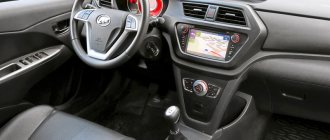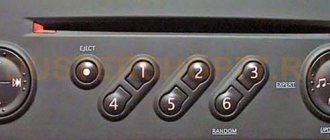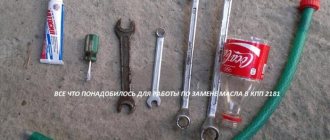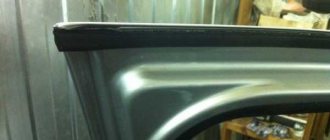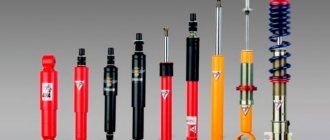Many car enthusiasts who are interested in the new AvtoVAZ hatchback know that, unlike Vesta, XRAY is not an independent development of the company. The new Lada is built on the basis of the Renault Sandero Stepway, but has significant improvements. Let's find out whether the VAZ team managed to take into account the mistakes of the French?
Exterior
Externally, both competitors look very attractive, and both Renault and Lada are made in an aggressive style and seem to compete in power. X Ray seemed to freeze, waiting for the starting whistle, only to take off at that very moment. The powerful front end, framed by faceted headlights, chrome stripes, an air intake and other elements of a modern hatchback, only confirms the intentions of the Lada XRAY.
For the front of X Ray, Steve Mattin is just right to shout: “Bravo”!
The profile emphasizes the advantages of the model. Stampings curved in an X-shape, stylish wheels, impressive ground clearance, a slightly inclined forward silhouette - all this can be safely considered an asset of X Ray. On the other hand, 16-inch wheels, of course, cannot be called modest, but in the massive wheel arches of the model even they seem small. However, there is talk about switching to the 17th radius, at least in relation to the Cross version. The rear of the hatchback, with its powerful fifth door and stylish lights, gives the car a special charm.
However, the car is also not lagging behind from the sides and rear.
Renault Duster also exudes aggression, but it is expressed in a slightly different style. The outline is more puffy and muscular, which is especially noticeable in the design of the wings. Its front end is richly decorated with chrome, and a large nameplate sparkles in the center. The impressive headlights go well with the fog lamp beads and the trim at the bottom of the bumper.
Renault also looks powerful, but the format is slightly different.
A powerful profile, with rectangular door outlines, lines and stampings, roof rails, branded wheels in swollen arches, high ground clearance - the list of the crossover’s strengths does not end there. From the rear, the car looks no less impressive - a large trunk lid, modest, rectangular feet, and also a bumper with a light-colored trim that goes far up.
From the side and from behind, the Frenchman is also impressive.
Technical features of the models
The domestic model LADA XRAY is created on a reliable, time-tested B0 platform, which is a frameless chassis where all elements are built into the underbody. Renault Sandero, Logan, Duster and other cars produced by the Renault-Nissan concern are built on the same platform, which made it possible to reduce costs and, consequently, the cost of the car. At the same time, the base was not just transferred as a carbon copy to the Lada X-ray; VAZ components also acted as many structural elements. The model assumes a transverse engine arrangement with front-wheel drive, the front suspension is independent MacPherson type, on springs, the rear is semi-independent, spring-link. The manufacturer did a good job of protecting the LADA XRAY body from corrosion, and also took care of the engine and engine compartment, providing metal protection. The Lada XRAY model is perfectly adapted for Russian operating conditions, which makes it similar to its competitor.
Renault Duster
The well-known old-timer on Russian roads, the number one SUV in Russia, winner of prestigious awards and simply a reliable car, Renault Duster, is also designed on the B0 platform using technical solutions that make it possible to give the crossover its own character. Renault Duster has a durable suspension, ground clearance of 210 mm, short overhangs and other successfully implemented parameters of geometric cross-country ability, allowing the car to overcome all the hardships of Russian roads, as well as off-road conditions. The Renault Duster can be equipped with front-wheel drive (Authentique and Expression versions) or all-wheel drive. The front suspension of the Renault Duster is independent MacPherson type, while the rear suspension is implemented depending on the type of drive. So for the 4X2 version a semi-independent suspension is used, and for the 4X4 - independent.
Specifications
Engines
In terms of the number of engines, competitors have parity - 3 units each. But in terms of technical data, the leadership should be given to Renault, because its engines are not only more advanced, but their list also includes a diesel option, which X-Ray lacks.
The base engine of the domestic model is an in-line, 4-cylinder power unit VAZ-21129 (16-valve), developed by Russian engineers. It has a transverse arrangement, and the power system is represented by fuel injection with electronic control. This design guarantees a peak power of 106 hp. With. (78.2 kW) at 5,800 rpm. And already at 4,200 rpm the maximum torque is reached, which is equal to 148 Nm.
VAZ-21129 is the base engine of the Lada X-Ray.
Such characteristics guarantee the Lada X-Ray with this engine acceleration to hundreds in 11.4 seconds, with maximum speed of 174 km/h. The consumption that you will have to pay for the dynamics is quite acceptable - 9.3/7.2/5.9 liters for the city, mixed mode and highway, respectively.
The starting power unit of the Renault Duster is a 114-horsepower (84 kW), 1.6-liter engine of the HR16DE series with a timing chain drive, also two pairs of cylinders and 16 valves. Renault's fuel injection is distributed, electronically controlled. With it, the French SUV develops peak power at 5,500 rpm, complementing this with a torque of 156 Nm at 4,000 rpm. The dynamics are quite decent - 10.9 seconds. (2x4) or 12.5 sec. (4x4), and the maximum speed is 166 km/h. Appetite – 9.3/7.4/6.3 l.
The Duster is initially equipped with an HR16DE engine.
The same engine is the second engine of the Lada X-Ray. However, there is nothing surprising in the fact that the Alliance shared its developments with AvtoVAZ. But this motor was adapted to Russian conditions. In particular, its power was reduced to 110 hp. With. (81 kW), and thrust decreased to 150 Nm. However, the speed of achieving these indicators remained the same - 5,500 and 4,000 revolutions. The dynamics are approximately equal to those of Renault - 11.1 seconds. But the maximum speed is noticeably higher and is 181 km/h. And the consumption of the Lada XRAY is less - 8.9/6.8/5.6 liters.
The same engine, but adapted for Russia, is also found on the Lada X-Ray.
The most powerful X-Ray engine turned out to be a 122-horsepower, 1.8-liter engine. This is a new development of domestic engineers. However, in the main points it repeats the previous engines - in-line layout, transverse arrangement of 4 and 16 valves and cylinders, respectively, injection power system, etc. With it, the Lada is noticeably more dynamic and exchanges 100 km in 10.9 seconds, accelerating to 186 km/ h, while consuming 8.6/6.8/5.8 l AI-95.
The new 1.8-liter Lada engine is the pinnacle of AvtoVAZ engineering.
But it’s not easy to give Renault the palm, since the remaining two engines are aimed at fundamentally different buyers. This is a 2-liter petrol unit and a 1.5-liter turbocharged diesel engine.
The petrol engine has 16 valves and develops 143 hp. With. (105 kW) power, supplemented by a torque of 193 Nm, thanks to which it is able to accelerate the SUV to hundreds in just 10.3 seconds, reaching a maximum of 180 km/h. You have to pay for this with a consumption of 10.1/7.8/6.5 liters.
The 2-liter gasoline power unit gives the Duster dynamics at a decent level.
But the diesel is aimed at a calmer audience. Of course, its acceleration is 13.2 seconds. It can’t be called a sprint car, and the top speed of 167 km/h is frankly not impressive, as is the output of 109 hp. With. (at 4,000 rpm), although for such a volume and 8-valve layout this is an excellent result. However, the thrust of 240 Nm, which is already available at 1,750 rpm, more than compensates for everything, coupled with diesel consumption at the level of 5.9/5.3/5.0 liters.
The presence of a turbodiesel is a strong trump card in the Russian market.
As you can see, this round remains with Renault Duster. Despite the equal number of engines and the commonality of one of them, the Frenchman’s 2-liter unit is superior to the 1.8-liter Lada XRAY engine, while there is no diesel option under the hood of the domestic hatchback.
Gearboxes
The situation here is twofold. In terms of manual transmissions, the leadership can be given to Renault Duster. After all, it offers both 5- and 6-speed transmissions, while AvtoVAZ, although it equips its cars with a pair of French-made mechanical units, both of them are 5-speed.
French manual transmissions are great for X-Ray.
However, Renault’s advantage is minimal and it primarily affects the aspect of efficiency, which can be increased by the presence of 6th speed.
The 6-speed Renault Duster makes the SUV more economical.
When it comes to automatic transmissions, both companies have chosen their own path. AvtoVAZ settled on a 5-band AMT, created on the basis of a manual gearbox type 21826. Renault chose a 4-band automatic transmission of a classic design. If you compare both units, it becomes clear that driving in the city is more comfortable in the Duster, whose transmission jerks less in traffic jams and changes gears more smoothly.
The Renault Duster automatic is not bad, but only 4-speed.
But on the track, X-Ray completely wins back, because listening to the raised tones of the engine of a French crossover, which clearly lacks 5th speed, is not the most pleasant experience. And in general, asking almost a million rubles for a car, Renault could fork out for a more modern, 5-band transmission.
AMT Lada XRAY outperforms the Frenchman's automatic transmission in terms of the number of gears.
Chassis
In this regard, the advantage of Renault Duster is obvious. However, this is achieved due to the presence of all-wheel drive versions, which X Rey lacks. Nissan Murano shared an electromagnetic clutch of the GKN type with Renault. At the same time, Lock mode operates at speeds of up to 80 km/h, which virtually eliminates the possibility of overheating. In addition, if on front-wheel drive versions the rear suspension is represented by a torsion beam, then all-wheel drive modifications already have a completely independent, multi-link design.
The multi-link chassis is not available in all versions of Renault.
Lada is not able to offer such variety. All its modifications are equipped exclusively with a torsion beam. In general, if we compare the X-Ray with the front-wheel drive versions of the Duster, then in terms of handling it will not be inferior to the Frenchman, and in some aspects, thanks to lower ground clearance and, as a result, less windage, it will surpass it. But the domestic hatchback does not reach the level of taxiing of all-wheel drive Renaults.
X Ray has no alternative to the torsion beam.
Is everyone equal at the beginning?
To be extremely objective, let’s break down all the pros and cons of the basic configurations, because it’s no secret that only the most budget version of a car can tell more about it than any other!
With the appearance of the Hyundai Creta (Greta) on the Russian market, it became clear that the Koreans decisively want to change the direction of their line, taking compact crossovers as a basis. At the same time, the car cannot be called small, because it is only five centimeters shorter than the Hyundai Tucson.
What can I say, the basic configuration of the Hyundai Creta (Start) with a 1.6 engine with 123 horsepower in terms of price starts at 749,900 rubles. For this money you buy not only a high-quality Korean crossover, but also a proprietary audio system with USB, AUX and Bluetooth connectors, adjustment of the steering column, front seats, power windows, power steering and other attributes of a comfortable and safe ride.
The price for the brand new Renault Kaptur (1.64, 114 hp) is offered at 859,000 rubles - a noticeable difference with the Korean new product, don’t you think? At the same time, the French crossover in the “Life” configuration (not to say that this is the basic version - the manufacturer, in principle, has renounced the budget versions of the “Captura”) is already equipped with air conditioning, and electric windows, and a key card, and a stability control system, and two airbags... By the way, the Creta also has two of them, but in the maximum configuration - six (due to curtain airbags), and not four.
The domestic Lada Xray (1.6 engine with 106 horsepower) compares favorably with the proposed new products in terms of price: AvtoVAZ asks only 589,000 rubles for the Optima package. For this amount, the car enthusiast receives not only a miracle of Russian engineering, but also a whole set of pleasant options such as a Bluetooth channel, front electric windows, adjustable steering wheel and seats, two airbags, a road stabilization system, remote control of the lock and access to the ERA-satellite system. GLONASS". For a domestic car - not bad at all!
But the Ford Ecosport 2 with a 1.6 engine of 122 horsepower fits well into the pricing policy segment of the Creta and Captura: the basic Trend configuration is estimated at 909,000 rubles, taking into account the offered discount. And in terms of options, it is not one iota inferior to new crossovers: already in the “base” there is a powerful air conditioner, electrically adjustable side mirrors, LED optics, electric windows and many different smaller “amenities” for the driver!
The Chinese Lifan X60 (1.8 engine, 128 “horses”), which is very popular in Russia, costs from 629,900 rubles in the “base”, which, I must say, sets it apart from other crossovers. In the “Basic” version (why bother with the name of the basic configuration?) the car is equipped with power steering, two airbags, the ability to adjust the steering wheel and seats, remote control of the central locking, multimedia system, etc.
Interior
Inside, many people like the Lada's interior better. Buyers find it more harmonious and attractive. Powerful dashboard wells set the driver up for a dynamic ride and emphasize aggression in appearance. The 3-spoke steering wheel also contributes to this. The center console is decorated with a large display, and there are no complaints about its ergonomics, and the design of the dashboard itself completes the composition - smooth and devoid of sharp transitions.
The tidy of the Russian hatchback looks fun and organic.
Everything else is also excellent - good visibility, high-quality finishing materials, a spacious rear row and minimal flaws in the assembly.
Renault Duster is created in a different style. Its interior is a modified and improved version of the interior of the previous generation, which was almost completely copied by Logan. But in the restyled version, the dashboard has become much fresher - chrome edging has diluted the previously dull dashboard, depriving it of orange backlighting has also benefited the interior, the black gloss goes well with other materials, the new steering wheel format looks noticeably more expressive than the previous one. However, unlike X-Ray, Duster’s interior is replete with sharp transitions, niches and other things. However, there are no complaints about the convenience, as well as about the seating in the front row and rear sofa.
After restyling, Renault's interior became noticeably fresher.
Comparison of Renault Duster and Lada X-RAY
Many people note the similarity of these cars. Both of them are made using modern technologies and adapted for use in domestic conditions. Therefore, the competition between them is not easy.
Appearance
Duster appearance
Renault Duster has the appearance of an SUV. Looks stylish and modern. The body contours are aggressive and the shapes are exaggerated, which makes this car recognizable. The image of the car is complemented by powerful roof rails and square doors. The ground clearance is quite high, the trunk lid is large.
Appearance Lada XRay
Lada X-Ray - the car's lines are sharp and aggressive . The front has characteristic features that make the car easy to recognize. Equipped with 16-inch wheels. At the front, the radiator grille and air intakes form a distinctive symbol. Ground clearance is 19.5 cm versus 205 cm in Duster. In terms of its dimensions, the Lada is inferior to the Frenchman. The Renault Duster body is longer and wider.
Interior
Interior of the Lada X-RAY car
The Lada's interior is more attractive and of higher quality, as car enthusiasts say . The interior design is well designed. All switches are conveniently located. The driver has a wide viewing angle. There is enough space inside for all passengers.
Salon Renault Duster
The interior of Duster has also been updated. Its design has become more modern. Chrome inserts appeared. The instrument panel has also become more beautiful. The seats in the cabin are comfortable and comfortable. The interior itself is larger than that of the Lada. Both cars are equipped with a cabin filter, which is not true. for example, about Lada Largus.
Engines
- Lada. It is equipped with three types of engines: two with a volume of 1.6 liters, and the third with a volume of 8.0 liters.
- Renault. Can be equipped with one of seven motors. Volume from 1.5 to 2.0 liters. One of the power units is diesel.
Transmission
Lada can be equipped with two types of gearboxes (manual) or automatic. Both manual transmissions are five-speed.
Renault is equipped with three types of gearboxes. Two of them are mechanical, and the third is automatic. The mechanics have 5 and 6 stages, and the automatic has four positions.
Exterior and geometry
If we compare the sizes of crossovers, the length of the Duster is approximately 10 cm, and the width is 5 cm more. In practice, this provides both advantages and disadvantages. On the one hand, the Renault’s trunk is 100 liters larger (475 versus 361), and the interior is a little more spacious, but it will be more difficult to maneuver in urban conditions.
As for aesthetic qualities, subjectively the LADA XRAY Cross looks more balanced, while the appearance of the Duster is spoiled by the massive rear end. In addition, additional “style” points for the domestic model are provided by branded alloy wheels and X-shaped stampings, which visually distinguish the car in the crowd.
